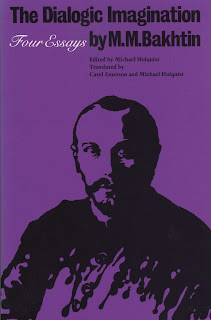 |
| M. M. Bakhtin (1981) The Dialogic Imagination: Four Essays. Edited by Michael Holquist; Translated by Caryl Emerson and Michael Holquist. University of Texas Press, Austin. |
Summary of Introduction (by Emerson and Holquist, presumably)
In this introduction, Emerson and Holquist, or one or the other of the two (it is not indicated; the term “I” is used, so perhaps it is Holquist, the editor) summarize Bakhtin’s life and work and introduce a few key concepts. One key argument is that Bakhtin’s thinking is characterized by a “Manichaean” opposition between centrifugal and centripetal forces in language. I’m not sure if “Manichaean” is quite the right word, because Bakhtin’s thinking on these two forces is ambivalent. In contrast to, for example, Norbert Wiener (for whom “entropy” is equivalent to evil), Bakhtin clearly favors the centrifugal; but he is also a bit like Deleuze and Guattari (whose striated and smooth spaces are clearly related concepts), when they admit that “a smooth space will not always save us” – for Bakhtin, some amount of centripetal or unifying force is important as well (as in his comments on “style” in the Dostoevksy book). Thus it seems that what Bakhtin is looking for is a kind of balancing, though favoring the centrifugal.
In relation to this, Holquist (or Emerson and Holquist) makes an interesting yet cryptic observation that Bakhtin does not reduce this dichotomy to a “binary opposition” such as those employed in structural linguistics. “That opposition leads from human speech to computer language; it conduces, in other words, to machines” (xviii). Here thinkers like Wiener, arguably also someone like Chalmers, is clearly implicated (though it is interesting to think how Haraway, for example, would respond). Nevertheless, to the extent that such a reductive, binarist/digital “conducement” to machines and computer language is something to be resisted, Bakhtin’s nuanced thinking could be useful; however, this observation is made only in passing and is not fleshed out.
Heteroglossia, in this account, becomes the interaction of the two opposed forces: the writer or speaker as unifying force drawing on (or in) the centrifugal, proliferating and novel speech of others, in a way that does not reduce them or their creative power.
The authors summarize Bakhtin’s vision of language as communication evocatively:
“Bakhtin’s basic scenario for modeling variety is two actual people talking to each other in a specific dialogue at a particular time and in a particular place. But these persons would not confront each other as sovereign egos capable of sending messages to each other through the kind of uncluttered space envisioned by the artists who illustrate most receiver-sender models of communication. Rather, each of the two persons would be a consciousness at a specific point in their history of defining itself through the choice it has made—out of all the possible existing languages available to it at that moment –of a discourse to transcribe its intention in this specific exchange.” (xx)
First of all, this recalls Felski’s complaint about the language of discourse “creating” subjects, etc.; and quite reasonably, since Emerson and Holquist are exactly the kind of 80s theorists she is talking about. Nevertheless this is a good example of why such language is not “unfortunate” but rather quite productive and important. Wiener also comes to mind because he specifically recognized the noise in such exchanges, and thus was more subtle than the straw man model of the naive “artists” evoked above. Yet, Wiener also assumes the two conversants as independent, previously existing, “sovereign” (in a literal sense because any entity is like a kingdom holding itself together against the forces of chaos) subject. The image of the situated, self-constructing subject not only improves on Wiener’s model but also allows for a more complex understanding of the uses of “noise” as these subjects are shown to be shielding themselves from, but also drawing on, such noise (“interference” in the text) in the next paragraph.
The authors, incidentally, make the assumption that Voloshinov is Bakhtin, so the above interpretation seems to bear the imprint of Voloshinov (his idea that there is no interiority beyond language, and that the utterance in the situated moment is the most important aspect of language).
It is clear that, for Bakhtin, these centrifugal (or entropic) forces are productive, rather than merely destructive, as Weiner would have it. And perhaps their world views are opposite: it is the eternally productive centrifugal which must be reined in by the centripetal (but not too much, because it must be allowed to remain itself) in order for order to be created (not just maintained). The authors end with a discussion of why Bakhtin feels the novel is so revolutionary and distinctive compared to other genres: it joyfully admits and makes use of its own limitations (and is always playing with and expanding on these). Such joyful inadequacy of the modern novel stands in contrast to Felski’s complaint that modern literature, through just such games, trains readers to be suspicious. If so, this is the fun suspicion of a game (something I do not recall her discussing so far). Presumably Felski will invoke a call for (non-suspicious) joyful reading in her conclusion, but here is a sign that it has been available in modernity all along.
No comments:
Post a Comment